Abstract
The responses of spleen cells from mice infected with Trypanosoma cruzi to stimulation with T (concanavalin A and phytohemagglutinin) or B (lipopolysaccharide) cell-specific mitogens were monitored during the acute, transition, and chronic states of the disease. A marked reduction in the responses of infected mouse cells with respect to those of uninfected animals was observed during the acute stage, regardless of whether or not the infective dose was lethal. Reduced or absent responses were recorded with suboptimal, optimal, and supraoptimal concentrations of the mitogens. Normal levels of responsiveness to concanavalin A, phytohemagglutinin, and lipopolysaccharide were observed during the chronic stage of the disease. The trend of return to normal responses was initiated around day 40 after infection with 25 parasites. At this time, a marked decline in parasitemia levels, cessation of mortality, and disappearance of visible signs of disease began to be observed defining the transition stage that precedes establishment of chronicity. T cell levels of the spleen were markedly reduced during the acute period and returned during the chronic phase. Instead, absolute levels of B cells were significantly increased during the acute period but also normalize in the chronic phase. Immunosuppression of chronically infected mice with cyclophosphamide led to a temporary return to acute infection-type conditions, even in animals with undetectable levels of parasitemia before treatment. These results suggest that reduced T cell responses during acute experimental Chagas' disease might in part to be due to depletion of the T cell compartment. Decreased B cell responses in the presence of significant numbers of B lymphocytes implies a suppressive phenomenon, B cell alteration, or a combination of both possibilities. Recrudescence of the disease after immunosuppression with cyclophosphamide suggests that immunological mechanisms play an important role, not only in the gain of control over T. cruzi infected by the host but also in the maintenance of the chronic status.
Full text
PDF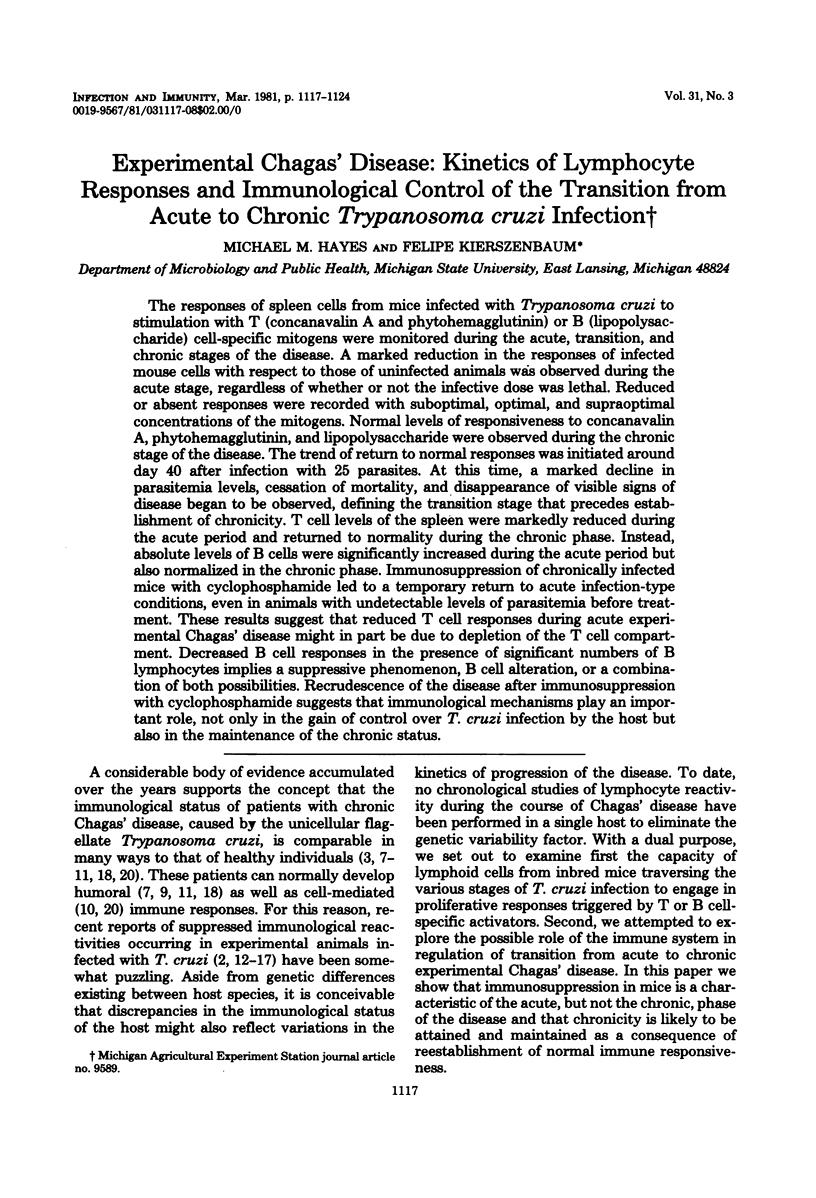
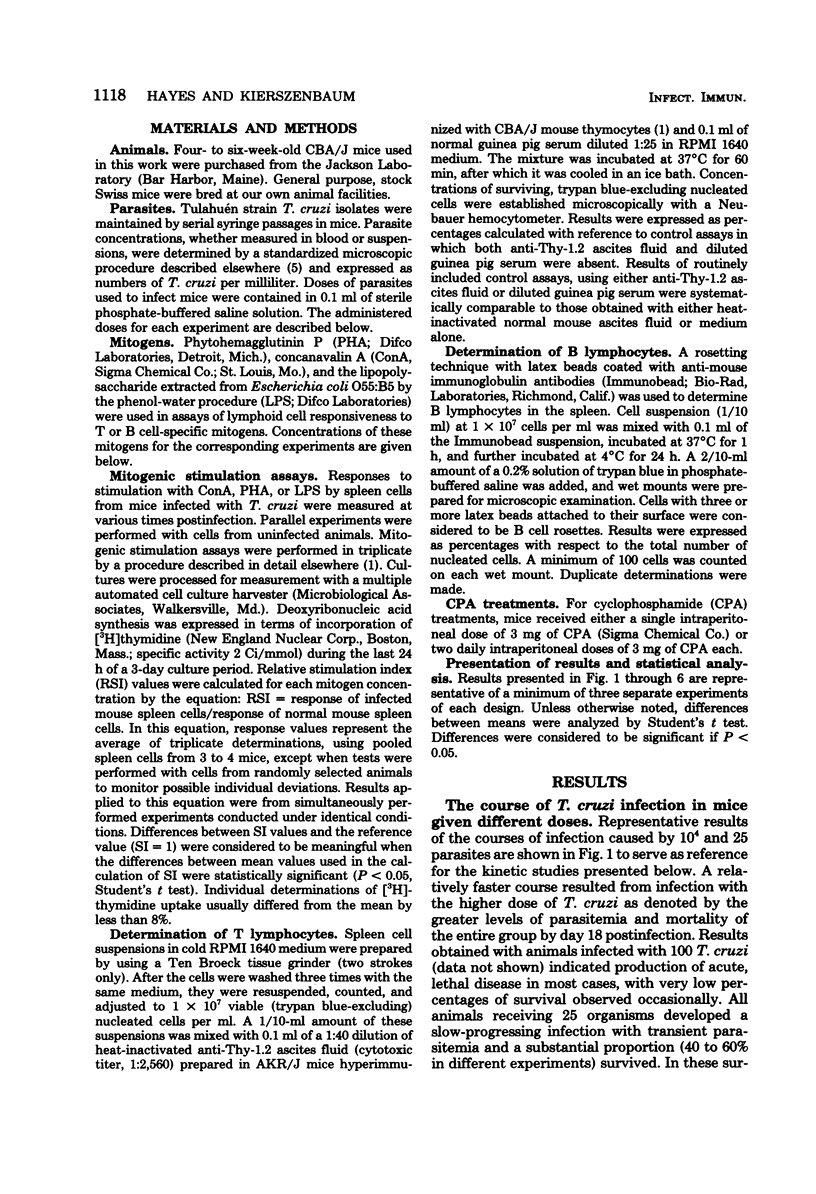
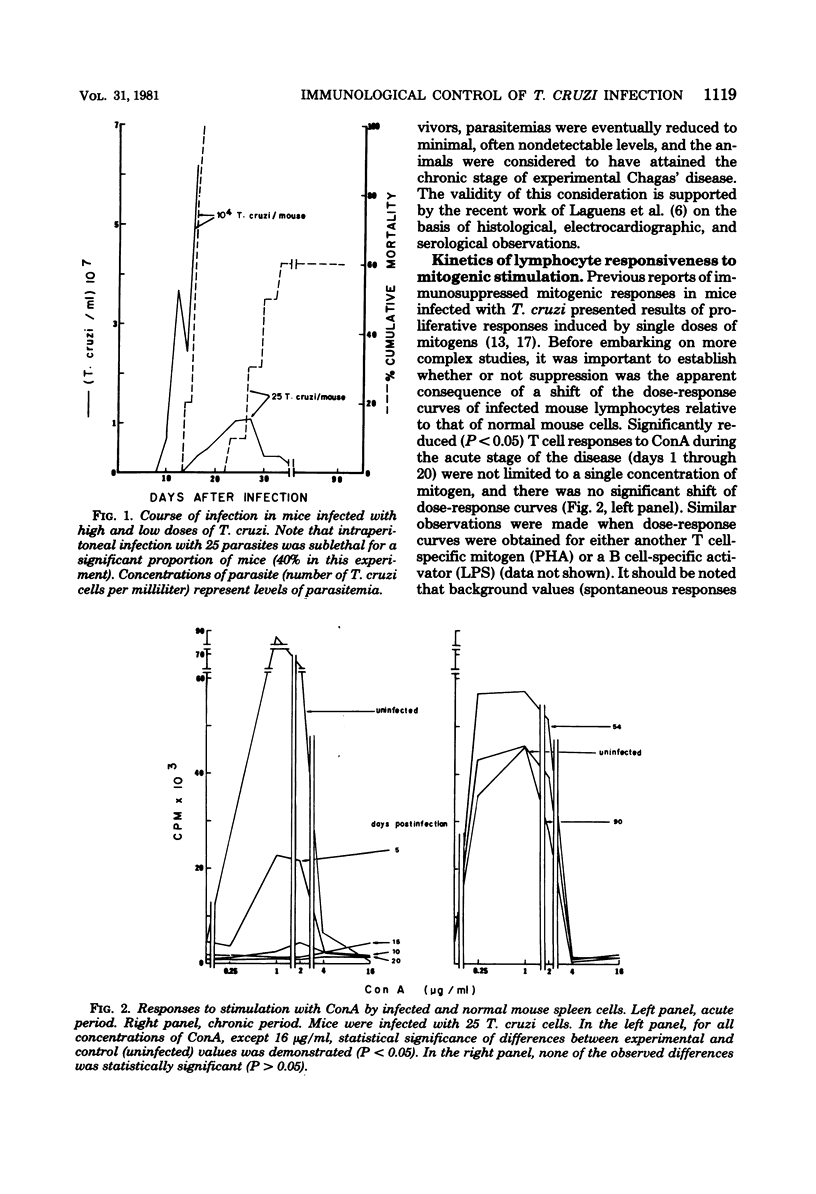
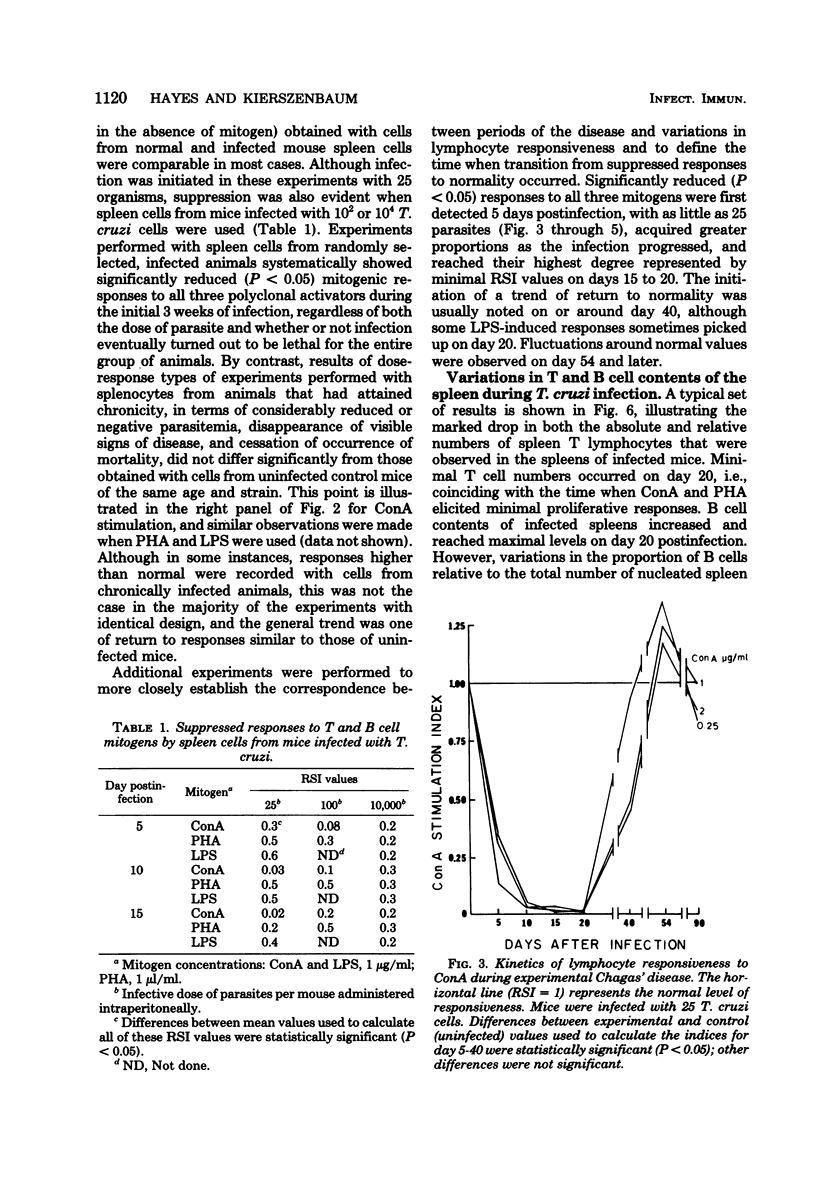
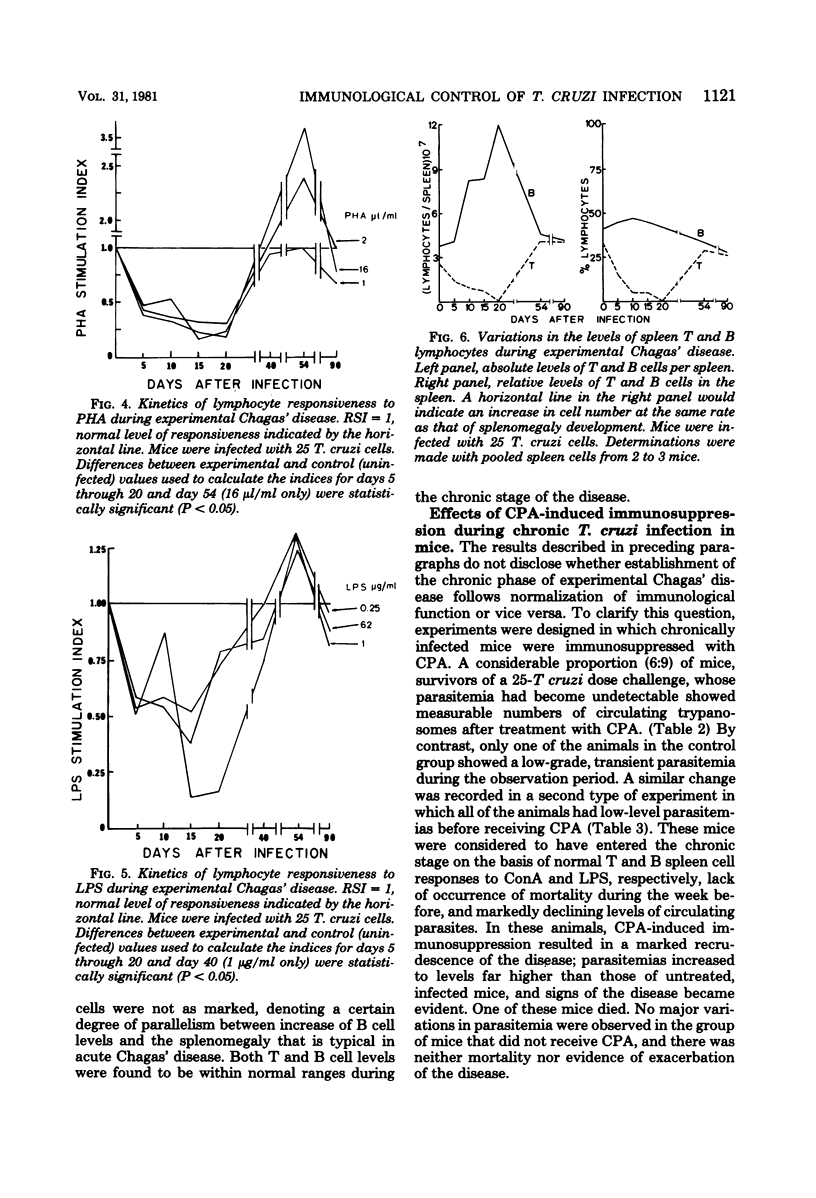
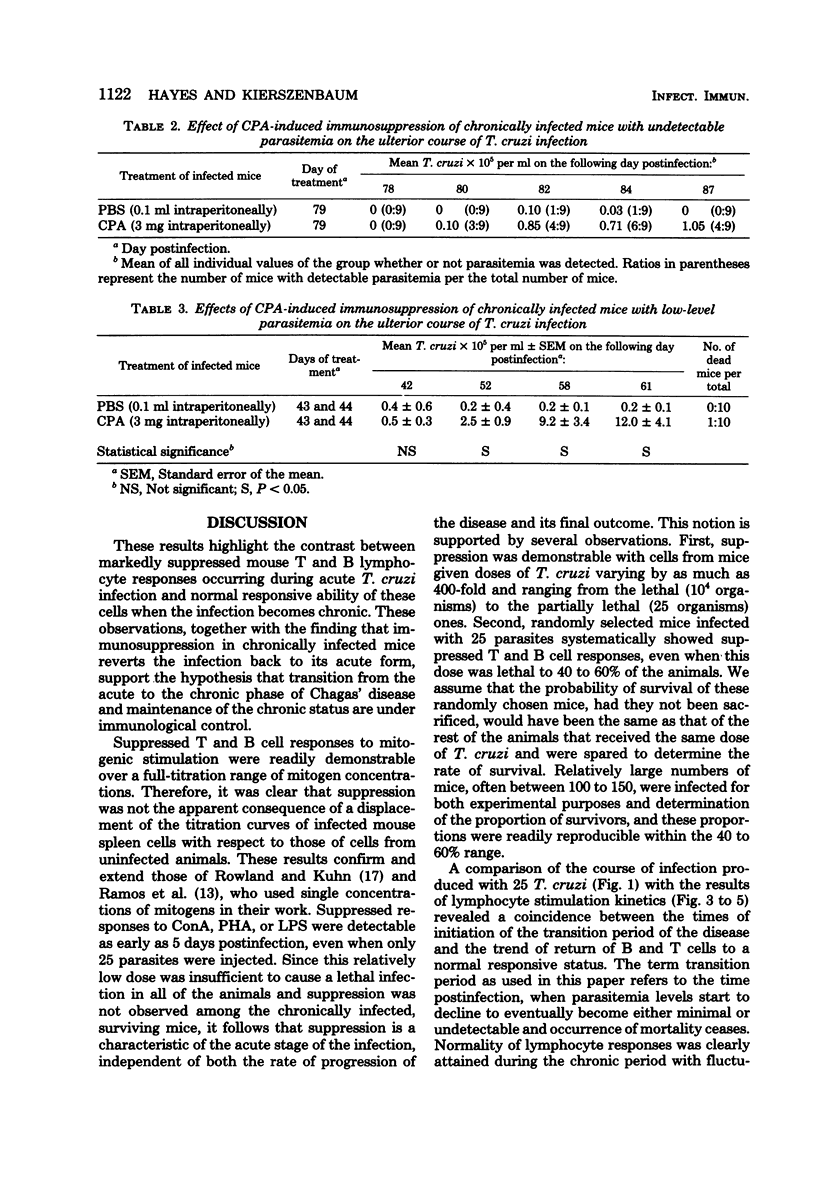
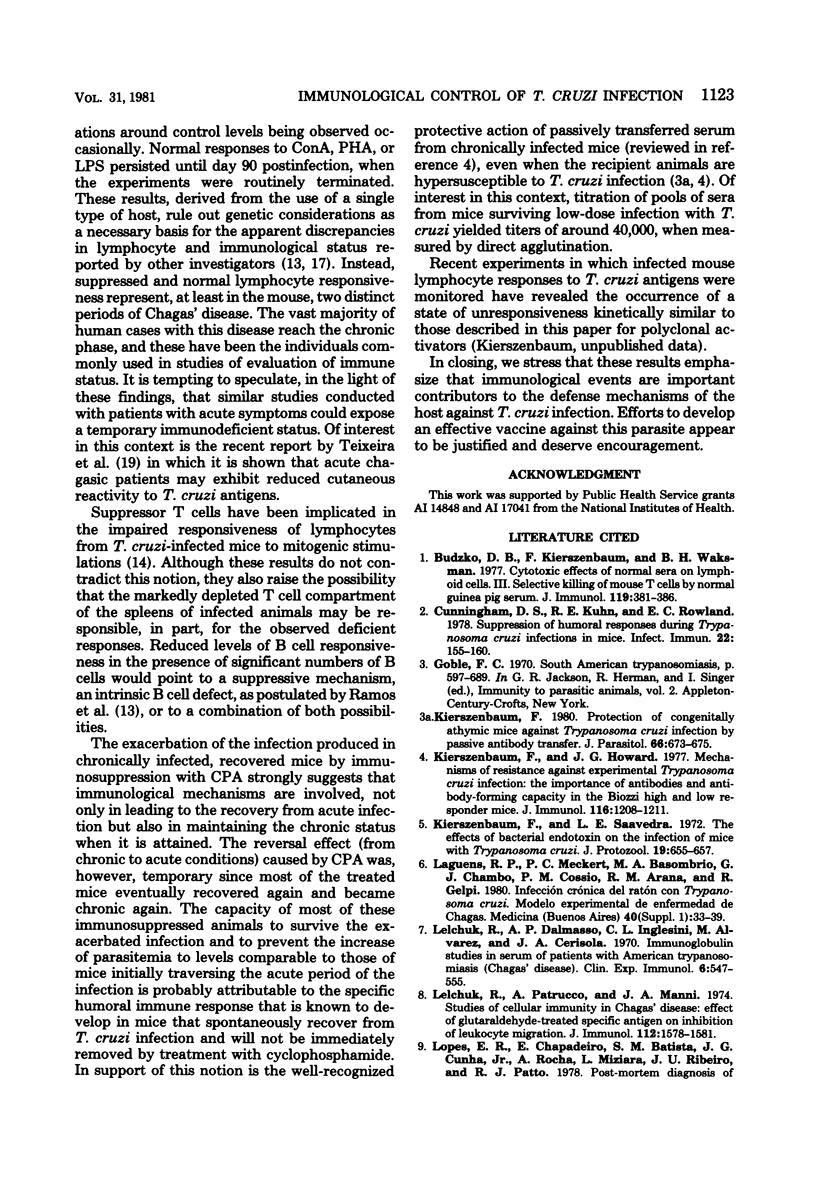
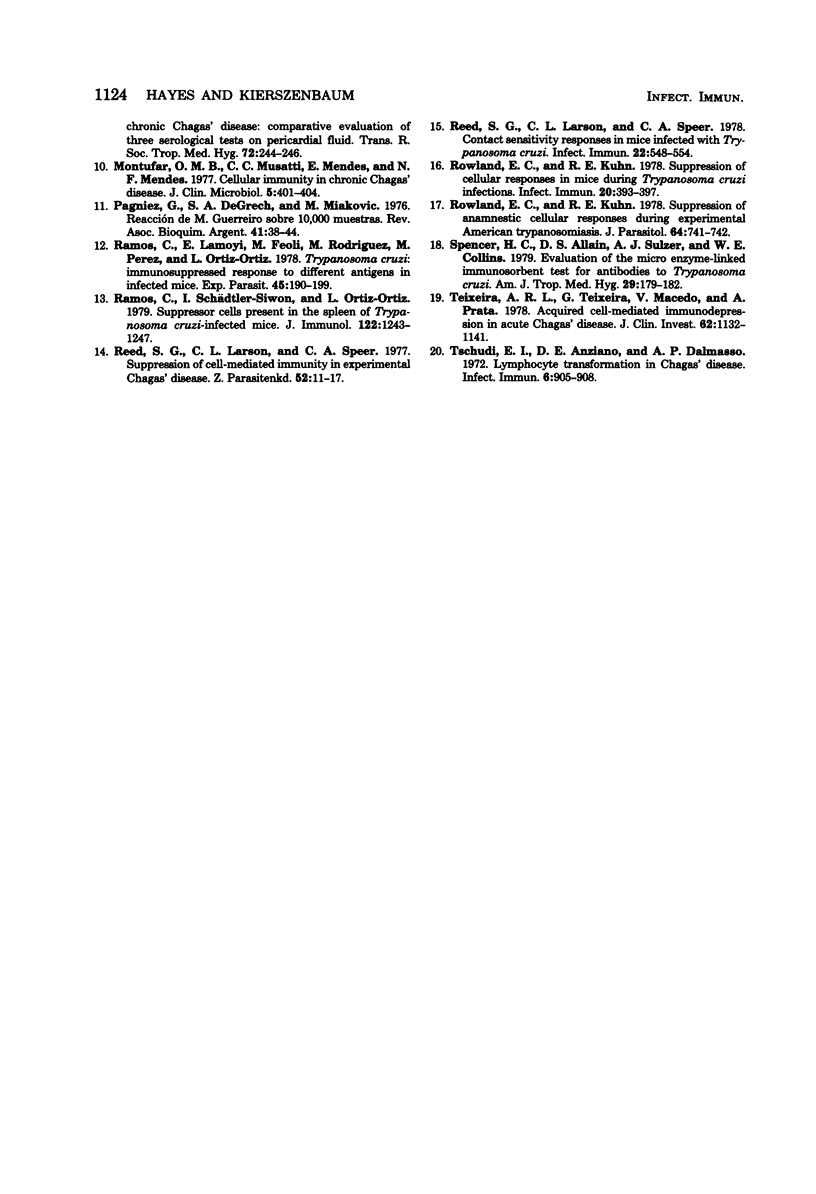
Selected References
These references are in PubMed. This may not be the complete list of references from this article.
- Budzko D. B., Kierszenbaum F., Waksman B. H. Cytotoxic effects of normal sera on lymphoid cells. III. Selective killing of mouse T cells by normal guinea pig serum. J Immunol. 1977 Aug;119(2):381–386. [PubMed] [Google Scholar]
- Cunningham D. S., Kuhn R. E., Rowland E. C. Suppression of humoral responses during Trypanosoma cruzi infections in mice. Infect Immun. 1978 Oct;22(1):155–160. doi: 10.1128/iai.22.1.155-160.1978. [DOI] [PMC free article] [PubMed] [Google Scholar]
- Kierszenbaum F., Howard J. G. Mechanisms of resistance against experimental Trypanosoma cruzi infection: the importance of antibodies and antibody-forming capacity in the Biozzi high and low responder mice. J Immunol. 1976 May;116(5):1208–1211. [PubMed] [Google Scholar]
- Kierszenbaum F. Protection of congenitally athymic mice against Trypanosoma cruzi infection by passive antibody transfer. J Parasitol. 1980 Aug;66(4):673–675. [PubMed] [Google Scholar]
- Kierszenbaum F., Saavedra L. E. The effects of bacterial endotoxin on the infection of mice with Trypanosoma cruzi. J Protozool. 1972 Nov;19(4):655–657. doi: 10.1111/j.1550-7408.1972.tb03552.x. [DOI] [PubMed] [Google Scholar]
- Laguens R. P., Cabeza Meckert P., Basombrío M. A., Chambó G. J., Cossio P. M., Arana R. M., Gelpi R. Infección crónica del ratón con Tryupanosoma cruzi. Modelo experimental de enfermedad de Chagas. Medicina (B Aires) 1980;40 (Suppl 1):33–39. [PubMed] [Google Scholar]
- Lelchuk R., Dalmasso A. P., Inglesini C. L., Alvarez M., Cerisola J. A. Immunoglobulin studies in serum of patients with American trypanosomiasis (Chagas' disease). Clin Exp Immunol. 1970 Apr;6(4):547–555. [PMC free article] [PubMed] [Google Scholar]
- Lelchuk R., Patrucco A., Manni J. A. Studies of cellular immunity in Chagas disease: effect of glutaraldehyde-treated specific antigen on inhibition of leukocyte migration. J Immunol. 1974 Apr;112(4):1578–1581. [PubMed] [Google Scholar]
- Montufar O. M., Musatti C. C., Mendes E., Mendes N. F. Cellular immunity in chronic Chagas' disease. J Clin Microbiol. 1977 Apr;5(4):401–404. doi: 10.1128/jcm.5.4.401-404.1977. [DOI] [PMC free article] [PubMed] [Google Scholar]
- Ramos C., Lamoyi E., Feoli M., Rodriguez M., Perez M., Ortiz-Ortiz L. Trypanosoma cruzi: immunosuppressed response to different antigens in the infected mouse. Exp Parasitol. 1978 Aug;45(2):190–199. doi: 10.1016/0014-4894(78)90059-0. [DOI] [PubMed] [Google Scholar]
- Ramos C., Schädtler-Siwon I., Ortiz-Ortiz L. Suppressor cells present in the spleens of Trypanosoma cruzi-infected mice. J Immunol. 1979 Apr;122(4):1243–1247. [PubMed] [Google Scholar]
- Reed S. G., Larson C. L., Speer C. A. Contact sensitivity responses in mice infected with Trypanosoma cruzi. Infect Immun. 1978 Nov;22(2):548–554. doi: 10.1128/iai.22.2.548-554.1978. [DOI] [PMC free article] [PubMed] [Google Scholar]
- Reed S. G., Larson C. L., Speer C. A. Suppression of cell-mediated immunity in experimental Chagas' disease. Z Parasitenkd. 1977 Jun 3;52(1):11–17. doi: 10.1007/BF00380553. [DOI] [PubMed] [Google Scholar]
- Rowland E. C., Kuhn R. E. Suppression of anamnestic cellular responses during experimental American trypanosomiasis. J Parasitol. 1978 Aug;64(4):741–742. [PubMed] [Google Scholar]
- Rowland E. C., Kuhn R. E. Suppression of cellular responses in mice during Trypanosoma cruzi infections. Infect Immun. 1978 May;20(2):393–397. doi: 10.1128/iai.20.2.393-397.1978. [DOI] [PMC free article] [PubMed] [Google Scholar]
- Spencer H. C., Allain D. S., Sulzer A. J., Collins W. E. Evaluation of the micro enzyme-linked immunosorbent assay for antibodies to Trypanosoma cruzi. Am J Trop Med Hyg. 1980 Mar;29(2):179–182. doi: 10.4269/ajtmh.1980.29.179. [DOI] [PubMed] [Google Scholar]
- Teixeira A. R., Teixeira G., Macêdo V., Prata A. Acquired cell-mediated immunodepression in acute Chagas' disease. J Clin Invest. 1978 Dec;62(6):1132–1141. doi: 10.1172/JCI109232. [DOI] [PMC free article] [PubMed] [Google Scholar]
- Tschudi E. I., Anziano D. F., Dalmasso A. P. Lymphocyte transformation in Chagas disease. Infect Immun. 1972 Dec;6(6):905–908. doi: 10.1128/iai.6.6.905-908.1972. [DOI] [PMC free article] [PubMed] [Google Scholar]


